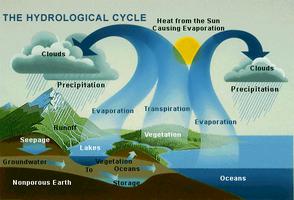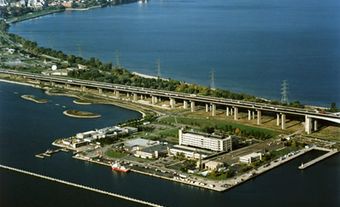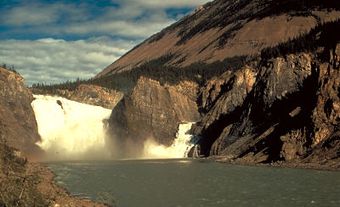
Hydrology
Hydrology studies the behaviour of WATER: its origin, distribution and circulation; its physical and chemical properties; and its interaction with the physical and living environment. Applied hydrology is primarily concerned with precipitation, with the occurrence and movement of frozen, impounded or flowing water (on or below Earth's surface) and with evaporation. More specifically, hydrology generally refers to the study of water on or over land rather than in the ocean. Hydrology is concerned with gathering information to determine quantities and rates of movement of water.Quantitative measurements of rainfall, snowfall, the rate at which water penetrates into and moves through soil, streamflow, the rise and fall of LAKE and GROUNDWATER levels, and the evapotranspiration of water into the atmosphere are vital. The science encompasses study of the physical laws governing the movement of water through the hydrologic cycle and the interaction of water with the rest of nature, depending upon various mathematical techniques to define and describe empirical relationships between the movement of water and the conditions and forces influencing it.
History
Practical application of hydrological principles preceded a thorough understanding. As early as 4000 BC the Sumerians developed a complicated, extensive irrigation system which lasted some 5000 years. Large-scale flood-irrigation agriculture in the Nile Valley developed at least as early as 3400 BC. In China waterworks date from before 2000 BC. The earliest known hydrological measurements date to 3500-3000 BC, when nilometers were first used to measure the levels of the Nile. Primitive rain gauges existed in India as early as the 4th century BC.
A few early thinkers seem to have had an exceptional understanding of hydrology, but it was not until 1580 AD when Bernard Palissy, a French natural scientist, wrote that RIVERS and streams were sustained by RAIN and SNOW, that the scientific world possessed a realistic description of the hydrologic cycle. A century later, Pierre Perrault and Edme Mariotte, French physicists, measured rainfall and runoff in the Seine River Basin and proved that rainfall was sufficient to account for river discharge. Soon afterward the English astronomer Edmond Halley measured evaporation and demonstrated that evaporation from the Mediterranean Sea could supply the rivers discharging into it.
In the late 1600s and 1700s the Italians Giovanni Cassini, Bernardino Ramazzini and Antonio Vallisnieri pioneered the theory of artesian water pressure, and important advances took place in hydraulic theory and instrumentation. Advances in GEOLOGY near the end of the 18th century set the stage for progress in groundwater hydrology. In the latter half of the 19th century, pressure to develop water supplies in Europe forced an intensive study of the field.
In the New World, early emphasis was placed on the measurement of streamflow. In the US and Canada, government programs to measure streamflow and compile records began before the 1900s. A network of climatological observation stations was also started. A statistical and empirical approach to analytical hydrology developed from continuous data collection. For example, using probability theory and the assumption that a record of rainfall or river flow is representative of the rainfall or flow in the future, hydrologists have derived methods for describing the likelihood of occurrence of hydrological events.
Approximate relationships between temperature and snowmelt, rainfall rate, ground cover and runoff, DRAINAGE BASIN area and FLOOD magnitude, permeability and groundwater yield, radiation and evapotranspiration, etc, have been defined and used in the solution of practical problems.
Education
In 1948 the first Canadian university course titled "Hydrology" was established by R. H. Clark for engineering students at the University of Manitoba. Thirty years later courses in various aspects of hydrology were being offered in over 40 universities across the country, generally by ENGINEERING and GEOGRAPHY departments. All CIVIL ENGINEERING students now receive some training in hydrology.
While there are no faculties dedicated exclusively to hydrology, several universities have hydrological postgraduate programs. Enrolment in these courses varies from year to year; approximately 40 MSc and PhD students graduated annually from Canadian universities during the late 1970s. Postgraduate courses tend to concentrate on the same topics (surface water, erosion, etc) touched on more briefly at the undergraduate level. The computer has made hydrological modelling an important part of graduate study.
Relationship to Other Fields
Because of the interrelatedness of water and nearly every other aspect of the natural environment, the lines dividing hydrology from other fields of study are blurred. METEOROLOGY is concerned with precipitation and evapotranspiration, GEOMORPHOLOGY with runoff patterns, geology with groundwater flow, soil science and soil mechanics with subsurface flow and plant physiology with transpiration. Supporting sciences, such as physics and mathematics, are necessary for detailed work.
Applications
Hydrologists advise water managers on the use and manipulation of water, for example, allocating limited water supplies among various users; sizing structures (eg, spillways, bridges) designed to pass flood flows safely; planning water management or HYDROELECTRIC systems intended to make optimum use of available supplies; forecasting floods and low flows; designing and operating RESERVOIRS, dikes and floodways; designing EROSION-control structures; discovering, inventorying and allocating water from deep underground sources; applying hydrologic principles to soil-plant-water relationships to aid in the production of food and fibre.
Societies and Journals
Canadian hydrologists enjoy professional contacts and journalistic outlets through a variety of associations. The Hydrology Section of the Canadian Geophysical Union sponsors hydrological symposia at regular intervals. The journal of the Canadian Meteorological and Oceanographic Society is Atmosphere-Ocean. The Canadian Water Resources Association publishes the Canadian Water Resources Journal and also sponsors hydrological symposia through its affiliate, the Canadian Society for Hydrological Sciences. The Canadian Society for Civil Engineering publishes through the Canadian Journal of Civil Engineering.
The Canadian Journal of Earth Sciences serves the groundwater hydrologist. The American Geophysical Union's Water Resources Research and various publications of the American Society of Civil Engineers and the National Water Well Association serve both American and Canadian needs. The International Association of Hydrological Sciences, which produces the Hydrological Sciences Journal, and the International Association of Hydrogeologists provide worldwide scientific communities for the hydrologist.
The Journal of Hydrology and Agriculture and Forest Meteorology are also important journals. Two specialized agencies of the United Nations are involved in hydrology. The World Meteorological Organization promotes coordination of operational aspects of meteorology and hydrology through its Commission on Hydrology. UNESCO's International Hydrological Decade, which promoted worldwide research in scientific hydrology 1965-74, was followed by its International Hydrological Programme. In both cases, Canadian scientific and management participation has been significant.

 Share on Facebook
Share on Facebook Share on X
Share on X Share by Email
Share by Email Share on Google Classroom
Share on Google Classroom


